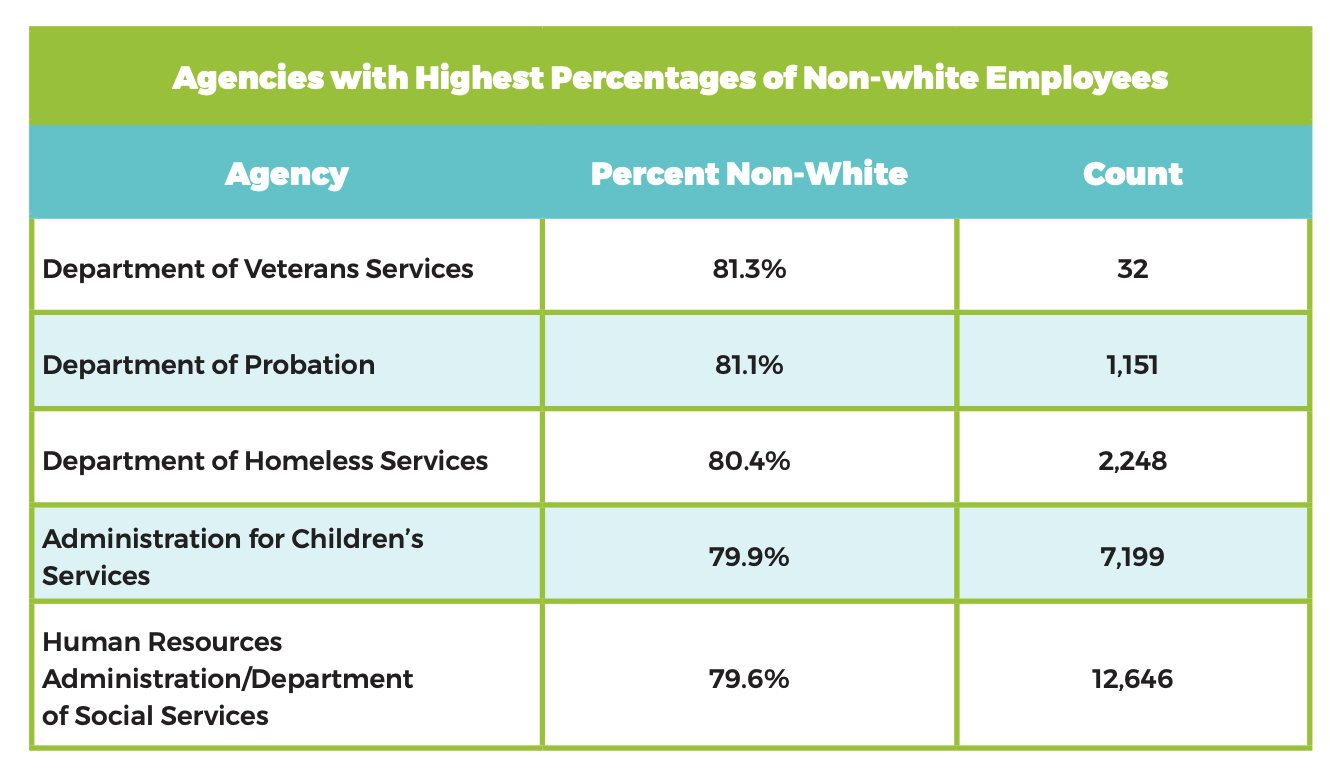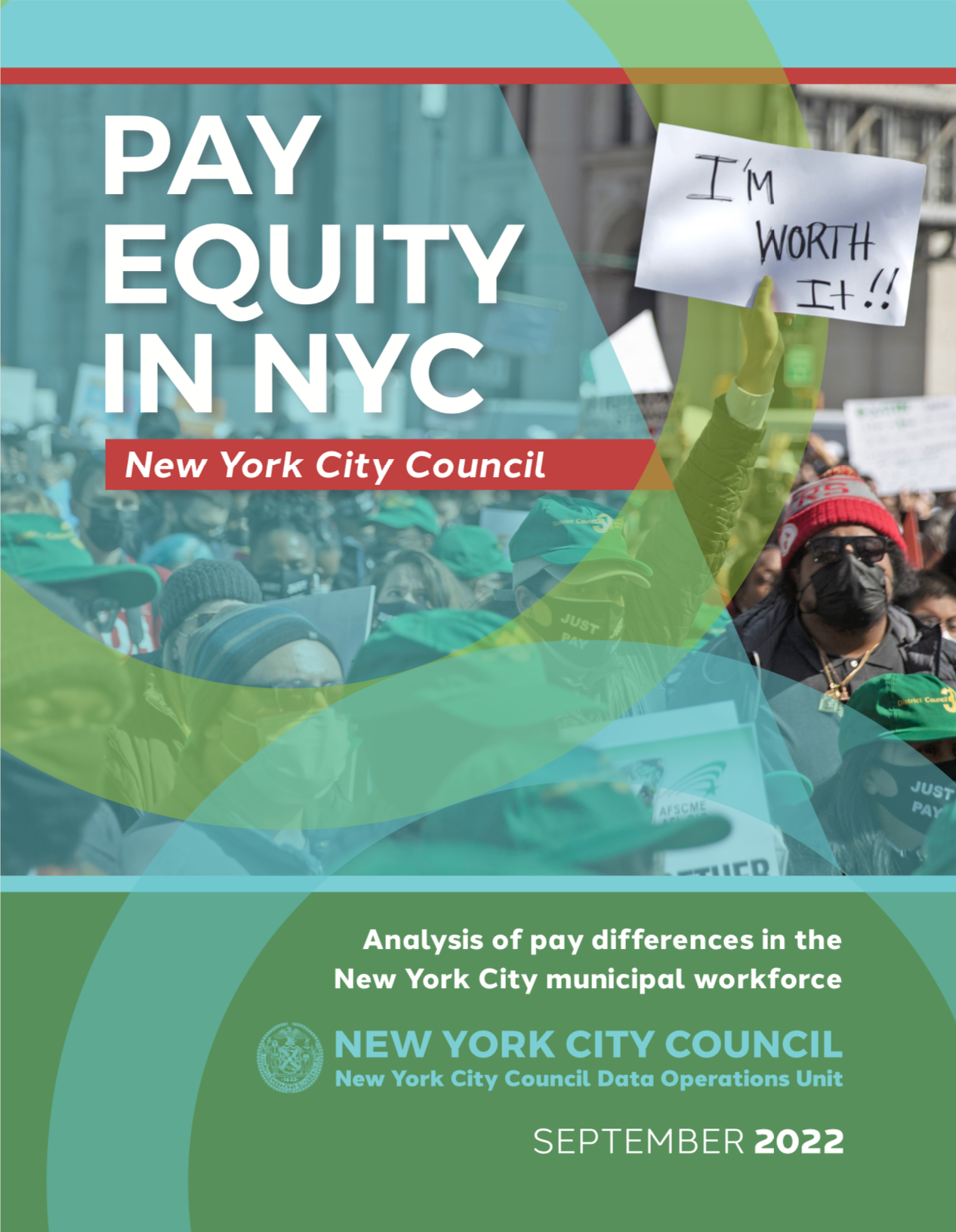In passing the Pay Equity Law (Local Law 18 of 2019), the Council took an innovative approach to reach a simple goal: to increase access to City data so that it could understand trends and pay gaps among City workers, and propose solutions to eliminate those disparities. In its first report, in 2021, the Council identified that a major root cause of pay disparity in the City workforce is occupational segregation – that certain demographic groups are over- and under-represented in different City jobs – and that pay disparity often correlates with how those jobs are valued. This report builds on that work, setting forth specific legislation that will work to narrow the pay gap.
The legislative package now being advanced by the Council enhances these efforts by strengthening the existing pay equity law; evaluating recruitment, retention, and upward mobility opportunities within and across City agencies; and analyzing pay so that compensation for City jobs is commensurate with the value they provide.
Those with the authority, power, and voice to make change have the responsibility to help ensure advancements. As the first women-majority Council, we will not rest until women — particularly women of color — are valued equally for their crucial contributions to our City. More than 300,000 New Yorkers serve this city of 8 million residents. Nearly 60% of that dedicated workforce consists of women, and more than half are Black and brown women. They field our 911 emergency calls, they clean our parks, they reintegrate formerly incarcerated persons back into communities, and they provide care for the most vulnerable among us. They keep this City running. The devaluing of work historically done by women must end. We will not stop until we are paid the equitable wages we deserve.
Sincerely,
Speaker Adrienne E. Adams
Summary
In 2019, the New York City Council (Council) passed Local Law 18, also known as the “Pay Equity Law,” to identify pay disparities among employees of the City of New York (NYC) based on race, ethnicity, gender, and other protected classes. The law requires the Mayor’s Office of Data Analytics (MODA) to report NYC municipal employee pay data publicly and to provide the Council with direct access to the data to facilitate its own annual statistical analysis.
In August 2021, the Council published a report containing its analysis of NYC municipal employee pay data for 2018 (the 2021 Pay Equity Report) . In the 2021 Pay Equity Report, the Council concluded that while municipal employees with the same civil service title generally receive equal pay, between civil service titles, employee demographics are often segregated along gender and racial lines. Moreover, the 2021 Pay Equity Report concluded that this segregation results in pay disparity due to significant differences in pay based on civil service titles.
This report builds on the observations and conclusions in the 2021 Pay Equity Report, based on additional data for 2019. The analysis compares the annual datasets provided to ascertain whether any progress is being made by the City towards closing the pay gap. The report includes a series of proposed legislation, intended to enhance the Council’s oversight of the City’s ongoing effort to achieve pay equity across the municipal workforce.
The Pay Equity Law expanded access to the City’s data to uncover the existence of pay disparities among the municipal workforce, so that the City can develop and implement solutions to achieve pay equity. Under the law, MODA must publicly report aggregated City pay data annually and assess it for disparities based on gender, race, and ethnicity. The Pay Equity Law also entitles the Council to directly access NYC employee pay data via an Application Programming Interface, or API, to facilitate independent verification of MODA’s findings. The Pay Equity Law is the first ever local law that grants the Council direct access to individualized data in this way, making possible the analysis that informs this report.
The non-adjusted pay gap is the median pay difference between two demographic groups when not accounting for other demographic categories or variables that may affect salary. For example, the non-adjusted pay gap compares the median salary for males to the median salary for females, regardless of their race, age, civil service title, or other known characteristics the individuals in those groups might hold.
The adjusted pay gap accounts for other variables that may affect salary. To make the adjustment, the Council’s Data Operations Unit employs a model that evaluates the pay differential between different demographic categories while adjusting for the following variables: the employee’s length of service, civil service title code, civil service title suffix, and civil service title level, agency, and managerial status. This model evaluates the adjusted pay gap between groups identified under a single demographic—e.g., gender, race/ethnicity, or age—when accounting for other variables.
While large, non-adjusted pay inequities exist across gender and race/ethnicity lines, the pay gap is nearly, although not completely, eliminated after adjusting for variables in the regression model. However, once the civil service title that an individual holds is omitted from the model and no longer adjusted for, large pay inequities across gender and race/ethnicity again become apparent.
For example, as the percentage of female and non-white employees who share a civil service title increases, the data shows a correlating decrease in the median salary for the civil service title. This suggests that the relationship between gender or racial/ethnic identity and a civil service title can explain the significant difference in pay between demographic groups. In other words, occupational segregation by race and gender is a driving force of the pay gap.
Key Findings
Analysis of the 2019 dataset largely yields the same conclusions as in the 2021 Pay Equity Report: pay differences still exist for individuals within the same civil service title after accounting for other variables, and occupational segregation appears to be the main driver of pay inequity across the municipal workforce.
Slight Improvement, but Inequities Remain
Adjusted Pay Gap
The pay gap shrinks dramatically when comparing individuals in the same civil service title. However, a small but significant pay difference remains for individuals in the same civil service title even after accounting for other employee characteristics.
- The adjusted pay gap between male and female employees is extremely small: 0.3%. Female employees make $0.997 on the dollar compared to male employees.
- Compared with white employees, Black or African American employees make $0.989 on the dollar, Hispanic or Latino employees make $0.990 on the dollar, and Asian workers make $0.992 on the dollar.
Non-Adjusted Pay Gap
This suggests that occupational segregation—the over- or under-representation of certain demographic categories of individuals in certain occupations— remains a driving force of pay inequity across the NYC municipal workforce.
A prominent non-adjusted pay gap exists between Black or African American, Hispanic or Latino, and white employees, as well as between male and female employees, in the NYC municipal workforce. However, the non-adjusted pay gap compares the average median salaries across different protected categories without considering any other employee characteristics.
Median Salary by Race/Ethnicity of City Workforce
Covered by Pay Equity Legislation
By Race/Ethnicity and Gender
Non-Adjusted Cents on the Dollar Earned
By Race/Ethnicity and Gender
- Female employees on average make $.73 to every dollar male employees make.
- Black or African American employees make $.71 to every dollar white employees make, Hispanic or Latino employees make $.75 to every dollar white employees make, and Asian employees make $.85 to every dollar white employees make.
Examples of Occupational Segregation
While different demographic groups (by gender and by race/ethnicity) are generally paid similar salaries for doing the same work (meaning they hold the same civil service title code, level, and suffix), different demographic groups of people tend to be clustered in different civil service titles within the NYC municipal workforce, leading to a general lack of diversity within some titles and over and under-representation of certain demographics within titles.
Below are some findings that illustrate this across the municipal workforce, between and within agencies, and between uniformed and non-uniformed titles.
Occupational Segregation across the Municipal Workforce
Civil Service Title Codes by Share of Non-White Female Employees per Title
of $70,044.
As the proportion of female employees increases from one civil service title code to another, the median salary generally decreases. Civil service title codes that are less than 10% female still make a median salary of $85,292, as they did in 2018, while civil service title codes that are 90% to 100% female make a median salary of only $56,580—a pay difference of $28,712.
Occupational Segregation Between Agencies
Many of the top five agencies with the highest percentage of non-white employees from 2018 remain in the top five for 2019, the one exception being that DOC was replaced by the Human Resources Administration/Department of Social Services.
Meanwhile, FDNY and the Department of Sanitation (DSNY) remain in the top five agencies with the lowest percentage of non-white employees in 2019. A table listing the agencies with the lowest percentages can be found in the report.

Occupational Segregation within Agencies
In 2018, the five agencies with the largest difference in median pay between male and female employees were: Department of Information Technology and Telecommunications (DOITT), Police Department (NYPD), Fire Department (FDNY), Sanitation (DSNY), and Environmental Protection (DEP). Case studies were performed for four of these agencies. Similar trends were found across the agencies, with higher paying titles mostly held by males, and a large proportion of the overall workforce being male, sometimes exclusively within certain titles.
For a deeper dive into diversity at FDNY, visit Evaluating Diversity at the FDNY.
The Firefighter title is still held almost entirely by male employees (98.7%, versus 98.8% in the 2018 data). Each level above Firefighter is held by an even higher proportion of male employees, and the highest paying roles are all promotions from Firefighter.
Since 2018, two new high earning job titles have been added: Agency Deputy Medical Director (5304B) and Assistant Commissioner (FD) (95039), earning a median salary of $167,216 and $162,740, respectively. While few people hold these titles, the former is predominantly male-occupied while the second is occupied by an almost equal numbers of males and females.
DOITT Salaries by Gender Composition
The Administrative Staff Analyst (10026) title appears to be an anomaly. There are a larger number of employees within the high-earning titles that are predominantly male; 88% of all high-earning employees are within titles that are mostly held by male employees.
Uniformed Civil Service Title Codes
When considering racial/ethnic pay disparity within the NYC municipal workforce, the high percentage of white uniformed employees stands out, as it did in the 2018 data.
Both datasets show 40% of all uniformed employees are white, compared to the NYC municipal workforce as a whole, which is only 31% white. When excluding uniformed officers, the remainder of the NYC municipal workforce is just 24% white. A chart illustrating this can be found in the report.
Recommendations
Based on its analysis of the 2019 data, the Council reaffirms the following recommendations; the City schould:
- Provide improved data so that the Council can conduct a more robust analysis and evaluation of pay gaps within and across agencies;
- Assess and expand the civil service pipeline, and improve hiring and recruitment practices; and
- Conduct a comparable worth analysis to better gauge the value of titles in the NYC municipal workforce.
In connection with these recommendations, the Council has introduced the following legislative package to improve data transparency and address pay inequities across the municipal workforce.
Legislative Package
Better Data
- Amend the existing Pay Equity Law by requiring DCAS to provide employee pay data under additional categories of information to enhance the identification and analysis of existing pay gaps in the NYC workforce;
- Expand the definition of agency to capture more of the NYC workforce, including pedagogues of DOE;
- Entitle the Council to NYC employee pay data year-round to facilitate independent analysis of employee pay data, enhance oversight of the Administration’s actions to address pay inequality, and generate further legislative and policy solutions.
Job Pipeline, Hiring Practices, and the Civil Service Exam System
- Require each NYC agency or department that requires applicants to take a civil service exam to report on a number of metrics related to those examinations in order to evaluate and expand diverse recruitment and retention within NYC government;
- Require reporting on agency or department training academies and programs to evaluate recruitment efforts across NYC government. DCAS would coordinate required data collection and reporting to the Council;
- Streamline existing requirements of DOE regarding the dissemination of information on civil service examinations to high school juniors and seniors.
Comparable Worth Analyses
- Require each NYC agency to include in their affirmative employment plans an analysis of compensation data and measures to address pay disparity and occupational segregation, diversity and inclusion training, schedule and workplace accommodations, and access to facilities, including accommodations for individuals with disabilities, gender appropriate bathrooms, and lactation rooms;
- Each agency head would be required to submit an annual report on the number of new full-time and part-time employees retained, promoted, terminated, or resigned, and their compensation. Each agency head would be required to submit an annual report on the number of new full-time and part-time employees retained, promoted, terminated, or resigned, and their compensation;
- Require the Equal Employment Practices Commission to conduct a comparable worth analysis annually to analyze compensation within agencies and across different agencies.
For feedback, comments, and questions please email DataInfo@council.nyc.gov.
Created by the NYC Council Data Team.

